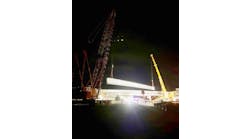By: Brian D. Bloom
The Bayview Bridge glows like a magnificent beacon in the night in Quincy, Ill., draped in different colors and shades, set against the backdrop of a picture-perfect evening.
Known as Illinois' "Gem City" on the Mississippi River, Quincy remains a prominent river city with a population of more than 40,000 citizens. Area residents on both sides of the river count on two bridges to get them to work and home on a daily basis. However, the bridges are not just functional, they are an icon to the communities on both sides of the river.
The Bayview Bridge brings westbound U.S. Highway 24 over the Mississippi River, connecting to West Quincy, Mo., and a vast floodplain of fertile farmland. The Bayview Bridge runs parallel to the Quincy Soldier’s Memorial Bridge, which takes the eastbound traffic U.S. 24 over the river. The bridges are a prominent feature of the public parks along Quincy’s riverfront.
Built in 1986, the Quincy Bayview Bridge is an early cable-stay bridge made with a reinforced concrete superstructure and pylons. The bridge has 56 cables set up in four planes, with each plane having seven cables on each side of the 182-ft main towers. Each pair of cables supports a 60-ft-long by 6-ft-thick bridge deck section. The sections were unique at the time of construction because they are a combination of prefabricated steel and precast concrete. In 2001, the bridge cables were wrapped with a white reflective coating to limit thermal elongation of the cables. Today, both of these innovative features are common on more recent cable-stay bridges.
Local assistance
Long a dream of local civic leaders, the city received a grant from IDOT in 2007 to illuminate the Bayview Bridge and make the Gem City sparkle. To bring this dream to reality, the city hired Klingner & Associates and Brown Electric Company to combine their expertise to provide a conceptual lighting plan, constructability review, and cost estimates for lighting the bridge structure. Based in Quincy, Ill., with a total of six locations, Klingner offers a wide range of professional services including civil engineering, mechanical/electrical engineering, environmental engineering and structural engineering, as well as architecture, interior design, planning, and land surveying and geotechnical/construction material testing services.
Established in 1929 with locations in Quincy, Ill., and Hannibal, Mo., Brown Electric provides electrical design, 24-hour service, new construction and arc flash analysis for the industrial, commercial, municipal, education and healthcare markets.
Originally envisioned as monotone white lights with optional colored filters for special occasions, the project evolved into a cinematic light show with the advent of high-lumen LED light fixtures. After performing on-site testing to demonstrate the viability of these fixtures to light the 180-ft tall concrete towers from the bridge deck, a final lighting concept was developed. This concept included above-deck lighting for the towers and the support cables, and below-deck lighting for the tower bases and the anchor piers at each end of the cable-stay span. Using digital multiplex (DMX) controls allows each fixture to be controlled individually and special effects such as fading to create light shows on the bridge structure.
The lighting system was supplied through a competitive bid process by Lighting Associates, located in Webster Groves, Mo. Lighting Associates represents more than 130 leading manufacturers offering a wide range of light fixtures and controls. They also provided all the custom programming to create the light shows using the DMX controls.
Robert Locke, project manager at Lighting Associates, said, “The scale and location of the bridge was a big challenge for several reasons. Since the bridge connected two states, we had to coordinate the project with two departments of transportation—Illinois and Missouri. We did not want to interrupt traffic patterns on the bridge or the river below while updating the lighting system. This includes the barge traffic on the river, which involves turning on and off the below-deck lights at night to help them navigate under the bridge.”
“Based on those criteria, we needed to find a lighting system that was energy efficient, provided great color saturation to highlight the architectural beauty of the bridge, and met the needs of both transportation departments,” added Locke.
Energy efficient
“Our design team did an excellent job providing a solution that is very energy efficient, easy to maintain, and meets the IDOT requirements,” Joe Knochel, P.E., architectural engineer at Klingner, said.
The final lighting design using LED fixtures resulted in a 72% reduction in energy consumption from the initial monotone-white concept with metal halide fixtures and an astounding 91% reduction from the initial estimates when the project was first envisioned in 2002. Actual energy usage has proven to be even less since the fixtures only achieve max power consumption when producing certain colors that utilize all four LED colors in the fixture simultaneously. The power consumption to light the bridge on a typical night is equivalent to running two hairdryers at the same time.
The reduced energy consumption also generated savings on initial installation cost, by allowing smaller power conductors and conduit to supply power to the fixtures. With a distance of 920-feet from the electric service to the first tower and another 1,340 feet to the far end of the cable-stay section, this proved to be a significant cost savings.
A gem at night
At night, the Bayview Bridge is highlighted by Dyna Drum HO and Dyna Flood QA luminaires from Acclaim Lighting in Los Angeles. An IP 66 wet-rated high-powered, quad-color architectural lighting fixture with a wireless DMX control option, Dyna Drum HO is ideal for facade and large-scale area flood lighting. The fixture features an adjustable yoke with onboard 180° flip inverted digital control display for menu selections and addressing for precise lighting control. With its energy-efficient AC internal power supply, Dyna Drum fixtures consume only 270 watts in replacing traditional 400-watt discharge fixtures. Its die cast aluminum housings are designed for excellent heat dispersion.
The color-changing Dyna Drum HO features RGBA chips, while the single-color version is available in temperatures of 2,700, 3,000, 3,500, 4,000 and 5,500 K, providing a lumen range of 9,000 to 17,232 at 5,500 K. The fixture is available in beam angles of 6° standard, with 25°, 40° and 60° spread lens options. It also offers a four-channel, DMX-512 control system, including both wired and wireless protocols built in.
Using Acclaim’s quad-color technology, the Dyna Flood QA contains four colors, RGB+amber, under a single lens. Quad-color technology mixes the colors under the lens, unlike traditional technology that color mixes outside of the lens, so Dyna Flood QA delivers precise color matching on the Bayview Bridge. It offers beam angles of 20°, 40° and 60°, and provides 1,233 lumens with efficacy of 20.55. Consuming 60 watts, the long-lasting units are warranted for five years and retain 70% of brightness at 50,000 hours.
Both Dyna Flood QA and Dyna Drum HO have die-cast aluminum housings available in gray, black and white to blend easily into the environment. The units mount to a standard 4-in.-round electrical box. For simple connection ability, they are designed with separate IP-rated power and signal cables, and bare end wires. With a DMX-512 control system, each unit features an auto-switching, multi-voltage power supply and an on-board touch-sensitive menu.
To control the lighting, the team selected a Mosaic controller from ETC in Middleton, Wis. The lights are DMX-controlled and have 16 custom programmed color sequences (shows), allowing the city to easily display different color schemes. The lighting scheme can be simply changed using a cell phone.
“The bridge is even able to match the color scheme of the local schools in the area with beautiful gold, orange and warms colors,” said Knochel. “The aesthetic illumination of the bridge has created a new focal point on the riverfront and provides a lasting impression at the west gateway to the Gem City.”
“It was an honor to be part of the job that was a first of its kind in our region and has greatly benefited the community we work and live in,” added Nathan Nuttelman, president of Brown Electric.
About The Author: Bloom is senior vice president at Falls Communications in Cleveland, Ohio.





